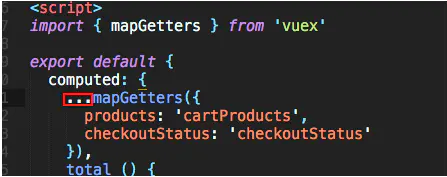vue辅助函数mapState和mapGetter前面三个点到底是什么意思:对象展开运算符

import store from "./store" computed: { useName: function() { return store.state.userName } }
mapState 函数返回的是一个对象。我们如何将它与局部计算属性混合使用呢?
通常,我们需要使用一个工具函数将多个对象合并为一个,以使我们可以将最终对象传给 computed 属性。但是自从有了对象展开运算符(现处于 ECMASCript 提案 stage-3 阶段),我们可以极大地简化写法:
computed: { // 使用对象展开运算符将此对象混入到外部对象中 ....mapState({ useName: state => state.useName }),
还可以按照如下方式使用mapState辅助函数:
在index.js文件中:
import Vue from 'vue' import Vuex from 'vuex' import mutations from './mutations' import actions from './action' import getters from './getters' Vue.use(Vuex) const state = { userInfo: { phone: 111 }, //用户信息 orderList: [{ orderno: '1111' }], //订单列表 orderDetail: null, //订单产品详情 login: false, //是否登录 } export default new Vuex.Store({ state, getters, actions, mutations, })
在需要使用store中的各个状态变量的自定义的vue组件中:
computed: { ...mapState([ 'orderList', 'login' ]), }, mounted(){ console.log(typeof orderList); ==>undefind console.log(typeof this.orderList)==>object }
mapState通过扩展运算符将store.state.orderList 映射this.orderList 这个this 很重要,这个映射直接映射到当前Vue的this对象上。
所以通过this都能将这些对象点出来,同理,mapActions, mapMutations都是一样的道理。牢记~~~
参考链接:mapState使用





 浙公网安备 33010602011771号
浙公网安备 33010602011771号